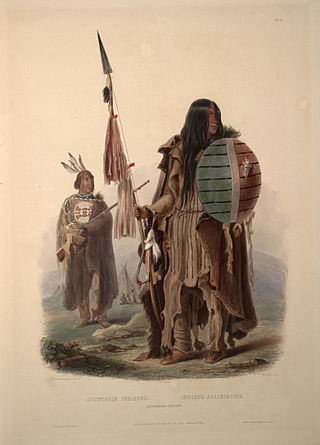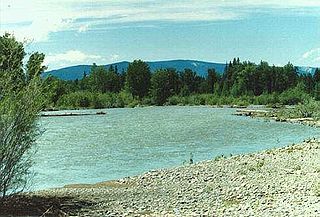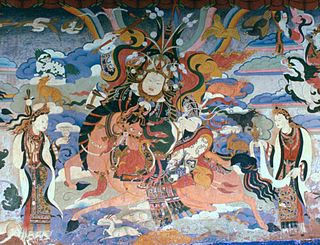Related Research Articles

The Crow, whose autonym is Apsáalooke, also spelled Absaroka, are Native Americans living primarily in southern Montana. Today, the Crow people have a federally recognized tribe, the Crow Tribe of Montana, with an Indian reservation, the Crow Indian Reservation, located in the south-central part of the state.

The Piegan are an Algonquian-speaking people from the North American Great Plains. They are the largest of three Blackfoot-speaking groups that make up the Blackfoot Confederacy; the Siksika and Kainai are the others. The Piegan dominated much of the northern Great Plains during the nineteenth century.
Salishan oral narratives consist of the body of traditional narratives of the speakers of the Salishan languages, who inhabit British Columbia, Canada and in Montana, Idaho, Washington, and Oregon in the United States. Each of the many peoples in these groups have their own stories and each storyteller may interpret them in their own ways, but many of the stories of the Salish peoples are similar and share themes and characters, and share their historical origins in the proto-Salishan culture long ago. The earliest descriptions of the oral traditions of the Salishan peoples were the collections of Nuxalk mythology by anthropologist Franz Boas.
The Blackfeet are a tribe of Native Americans who currently live in Montana and Alberta. They lived northwest of the Great Lakes and came to participate in Plains Indian culture.

The Indigenous peoples of the Americas comprise numerous different cultures. Each has its own mythologies, many of which share certain themes across cultural boundaries. In North American mythologies, common themes include a close relation to nature and animals as well as belief in a Great Spirit that is conceived of in various ways.

The Blackfoot Confederacy, Niitsitapi, or Siksikaitsitapi, is a historic collective name for linguistically related groups that make up the Blackfoot or Blackfeet people: the Siksika ("Blackfoot"), the Kainai or Blood, and two sections of the Peigan or Piikani – the Northern Piikani (Aapátohsipikáni) and the Southern Piikani. Broader definitions include groups such as the Tsúùtínà (Sarcee) and A'aninin who spoke quite different languages but allied with or joined the Blackfoot Confederacy.

Lake Missoula was a prehistoric proglacial lake in western Montana that existed periodically at the end of the last ice age between 15,000 and 13,000 years ago. The lake measured about 7,770 square kilometres (3,000 sq mi) and contained about 2,100 cubic kilometres (500 cu mi) of water, half the volume of Lake Michigan.

The Clark Fork, or the Clark Fork of the Columbia River, is a river in the U.S. states of Montana and Idaho, approximately 310 miles (500 km) long. The largest river by volume in Montana, it drains an extensive region of the Rocky Mountains in western Montana and northern Idaho in the watershed of the Columbia River. The river flows northwest through a long valley at the base of the Cabinet Mountains and empties into Lake Pend Oreille in the Idaho Panhandle. The Pend Oreille River in Idaho, Washington, and British Columbia, Canada which drains the lake to the Columbia in Washington, is sometimes included as part of the Clark Fork, giving it a total length of 479 miles (771 km), with a drainage area of 25,820 square miles (66,900 km2). In its upper 20 miles (32 km) in Montana near Butte, it is known as Silver Bow Creek. Interstate 90 follows much of the upper course of the river from Butte to Saint Regis. The highest point within the river's watershed is Mount Evans at 10,641 feet (3,243 m) in Deer Lodge County, Montana along the Continental Divide.
Blackfoot music is the music of the Blackfoot people. Singing predominates and was accompanied only by percussion.

The Assiniboine or Assiniboin people, also known as the Hohe and known by the endonym Nakota, are a First Nations/Native American people originally from the Northern Great Plains of North America.

Philippine mythology is rooted in the many indigenous Philippine folk religions. Philippine mythology exhibits influence from Hindu, Muslim, Buddhist, and Christian traditions.

Dry Falls is a 3.5-mile-long (5.6 km) scalloped precipice with four major alcoves, in central Washington scablands. This cataract complex is on the opposite side of the Upper Grand Coulee from the Columbia River, and at the head of the Lower Grand Coulee, northern end of Lenore Canyon. According to the current geological model, catastrophic flooding channeled water at 65 miles per hour through the Upper Grand Coulee and over this 400-foot (120 m) rock face at the end of the last glaciation. It is estimated that the falls were five times the width of Niagara Falls, with ten times the flow of all the current rivers in the world combined.

Glooscap is a legendary figure of the Wabanaki peoples, native peoples located in Vermont, New Hampshire, Maine and Atlantic Canada. The stories were first recorded by Silas Tertius Rand and then by Charles Godfrey Leland in the 19th century.
The Fifth World in the context of creation myths describes the present world as interpreted by several indigenous groups in the USA and Mexico. The central theme of the myth holds that there were four other cycles of creation and destruction that preceded the Fifth World. The creation story is taken largely from the mythological, cosmological, and eschatological beliefs and traditions of earlier Mesoamerican cultures.

The Blackfoot River, sometimes called the Big Blackfoot River to distinguish it from the Little Blackfoot River, is a snow-fed and spring-fed river in western Montana. The Blackfoot River begins in Lewis and Clark County at the Continental Divide, 10 miles (16 km) northeast of the town of Lincoln. The river's headwaters are between Rogers Pass to the north and Stemple Pass to the south. It flows westward through the town of Milltown and enters the Clark Fork River approximately five miles (8 km) east of the city of Missoula.
A pipe bag or tobacco bag is a common item used by some Native American ceremonial people. A pipe bag may be used to carry a sacred pipe, such as a Chanunpa.

The Mongol mythology is the traditional religion of the Mongols.

Darrell Robes Kipp was a Native American educator, documentary filmmaker, and historian. Kipp was an enrolled member of the Blackfeet Nation in Montana and was instrumental in teaching and preserving the Blackfoot language as the director of the Piegan Institute.

Napi Rock is located in the Lewis Range, Glacier National Park in the U.S. state of Montana. Napi Rock is a pinnacle on the eastern end of Singleshot Mountain and is easily seen from Saint Mary, Montana. Napi Rock is named for Napioa also known as Nah-pee, a fictional creation myth figure of the Blookfoot who was believed to have created the earth and everything on it.
References
- 1 2 3 4 5 6 7 8 9 Maclean, John (1893). "Blackfoot mythology". The Journal of American Folklore. 22. 6 (July–Sept): 165–172. doi:10.2307/533004. JSTOR 533004.
- ↑ Grinnell, George (1913). Native American Legends: Blackfoot Legends-Blackfoot Creation. George Bird Grinnell.
- ↑ Wissler, Clark; Duvall, R.C. (1908). "MYTHOLOGY OF THE BLACKFOOT INDIANS". Anthropological Papers of the American Museum of Natural History. 2: 19. hdl:2246/206.
- 1 2 3 Duvall, D.C.; Clark Wissler (1995). Mythology of the Blackfoot Indians. Lincoln, NE: University of Nebraska Press. p. 19. Archived from the original on 2008-08-03. Retrieved 2017-08-24.